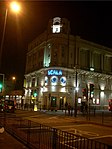The Poor School

The Poor School and Workhouse Theatre was a drama school situated in King's Cross, London, United Kingdom. The Poor School was created in 1986 by former Royal Central School of Speech and Drama vocal coach Barbara Caister in response to the need for first-class acting training which was financially within the reach of all, or almost all, and later taken over by her son, Paul Caister who ran the school for over 30 years. The two-year training programme at the school was in operation for 32 years, with graduates enjoying careers in theatre, film, radio, stage and comedy; ex-students have founded their own companies (Ridiculusmus and Sturdy Beggars, most notably) and have become producers, directors, casting directors and agents. The Poor School was not accredited by Drama UK and did not issue diplomas or certifications. It was announced in November 2016 that The Poor School was no longer accepting new students and the school closed at the end of July 2018. Its founder declined to comment on the reasons for the closure.The school offered a 2-year training programme and short courses. Shortly before The Poor School closed its doors, several long-serving staff members established The School in nearby Canonbury, offering a two-year acting training and short courses. Like The Poor School, training at The School is timetabled around evenings and weekends to allow students to work and earn whilst they train.
Excerpt from the Wikipedia article The Poor School (License: CC BY-SA 3.0, Authors, Images).The Poor School
Pentonville Road, London Barnsbury (London Borough of Islington)
Geographical coordinates (GPS) Address External links Nearby Places Show on map
Geographical coordinates (GPS)
| Latitude | Longitude |
|---|---|
| N 51.5311 ° | E -0.1199 ° |
Address
The Poor School
Pentonville Road
N1 9NL London, Barnsbury (London Borough of Islington)
England, United Kingdom
Open on Google Maps










